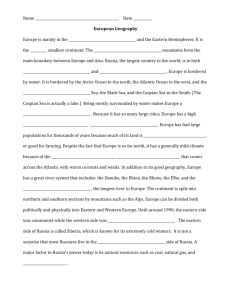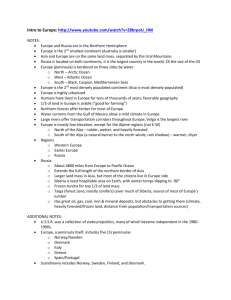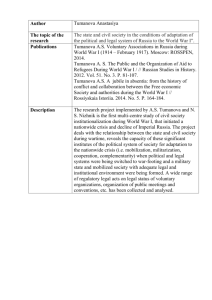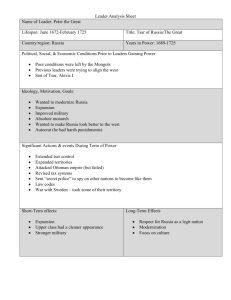Russia's Physical Geography
advertisement
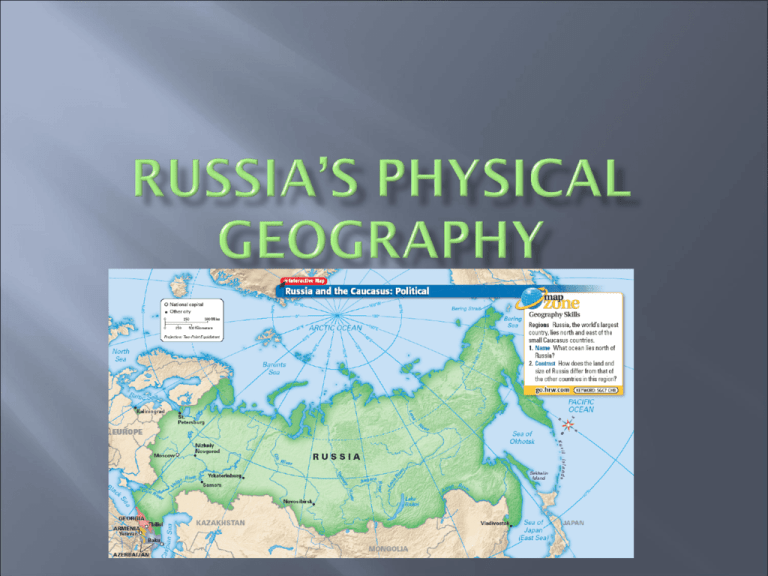
The Big Idea Russia is big and cold with vast plains and forests; whereas the Caucasus countries are small, mountainous, and warmer. Main Ideas • The physical features of Russia and the Caucasus include plains, mountains, and rivers. • Climate and plant life change from north to south in Russia and vary in the Caucasus. • Russia and the Caucasus have a wealth of resources, but many are hard to access. Continents of Europe and Asia meet at the Ural Mountains. Europe to the west Asia to the east Together, they form the landmass of Eurasia. Russia is the world’s largest country. Twice the size of the United States South of Russia is a region known as the Caucasus. It lies in the Caucasus, the area between the Black Sea and the Caspian Sea. Region named for the Caucasus Mountains. Includes three smaller countries—Georgia, Armenia, and Azerbaijan Russia’s capital, Moscow, is located in the Northern European Plain, which stretches across western, or European, Russia. To the east are the low-lying Ural Mountains, which are worn down and rounded from erosion. Siberia, the vast area between the Urals and the Pacific Ocean, includes the marshy West Siberian Plain, the Central Siberian Plateau, and mountain ranges. Russian Far East, in Eastern Siberia, is part of the Ring of Fire. Caucasus countries consist mainly of rugged uplands and mountains, including Mount Elbrus, the highest peak in Europe. South of the Caucasus Mountains is a plateau. Lowlands lie along the Black and Caspian Seas. Rivers Volga River, in western Russia Longest river in Europe Core of Russia’s river network Lakes Ob, Yenisey, and Lena rivers in Asian part of Russia Flow northward to Arctic Ocean Russia has some 200,000 lakes. Lake Baikal, in south-central Siberia, is world’s deepest lake. Deep enough to hold all the water in all five of the Great Lakes Called the Jewel of Siberia Seas • Black and Caspian seas border Russia and the Caucasus. – Black Sea connects to the Mediterranean Sea and is important for trade. – Caspian Sea holds saltwater and is the world’s largest inland sea. Russia has short summers and long, snowy winters due in part to its location along Arctic Circle. Russia’s northern coast is tundra. Much of the ground is permafrost, or permanently frozen soil. Only small plants such as mosses grow there. Taiga, a vast forest of evergreen trees, covers about half of Russia. South of the taiga is a flat grassland called the steppe. Rich, black soil and a warmer climate make this an important farming area. Caucasus countries are warmer than Russia. Warm and wet along Black Sea Hot and Dry in much of Azerbaijan Natural Resources Energy Resources Resource Management • Fertile soil for farming in Northern European plain and steppe • Wood from taiga for building and paper products • Metals and precious gems • Main energy resources include coal, hydroelectricity, natural gas, and oil. • Russia and Azerbaijan have large oil and gas fields. • Poorly managed for a long time • Many remaining resources are only in remote Siberia.


